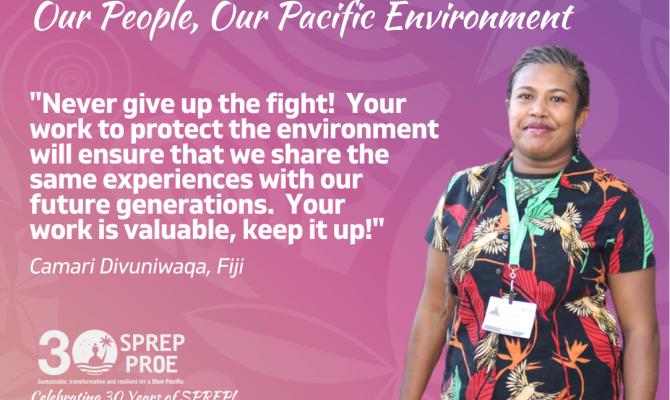The SPREP Treaty was signed in 1992, in Apia, Samoa. Under the Treaty, the purpose of the organisation is to provide assistance to the Pacific to protect and improve the environment and to ensure sustainable development for present and future generations.
Through its work, SPREP strives to support and empower young Pacific people working to build a resilient Pacific in the face of the countless challenges it faces today.
In 2022, Camari Divuniwaqa of Fiji was selected from hundreds of applicants to join the Global Youth Biodiversity Network in Montreal for the 15th Convention on Biological Biodiversity Conference of the Parties (CBD COP15). She represented the voice of Pacific youth in amplifying the call for more action in the fight to save the world’s declining biodiversity.
Divuniwaqa is currently undertaking her PhD in Soils Science at the Papua New Guinea University of Technology, and she shares in this Q&A her experiences as a young Pacific person working in our Pacific environment space.
Q: What Pacific environmental challenge do you work to address?
A: My research focused on restoring degraded land through the use of biochar. Biochar is derived from natural biomass, it is a fine-grained and porous substance, similar to charcoal, intended to be added to soil to improve its fertility. Whilst completing my Masters thesis three years ago, I realised that most barren lands can be restored. Land restoration will increase farmland, and this will increase food security.
Q: Having worked in partnership with SPREP, what are two key work activities or outcomes you are most proud of?
A: In 2022, I was selected by the Global Youth Biodiversity Network (GYBN) to be a representative of Pacific Island youth at the CBD COP15, held from 3 – 19 December 2022 in Montreal, Canada. Through SPREP’s support, I was nominated as a speaker to represent Pacific youth at the UN International Forestry Student Association side event. I was able to shed light on the special circumstances of our Pacific Island countries that need to be recognised
Q: In a sentence, what does an environmentally Resilient Pacific look like to you?
A: An environmentally Resilient Pacific is a stronghold of our Pacific governments, stakeholders and people working together to preserve traditional knowledge and biodiversity, adapting to environmental problems and building capacity so young Pacific islanders are well aware of their surroundings.
Q: What advice would you give to young people working in the environment?
A: Never give up the fight! Your work to protect the environment will ensure that we share the same experiences with our future generations – eating a variety of food crops, seafood, and vegetables, sunbathing on white sandy beaches and swimming in clean rivers. Your work is valuable, keep it up!
Q: What message do you have for the Secretariat as we celebrate 30 Years of service to our Pacific?
A: I would like to commend SPREP on their 30 years of hard work holding the banner of the Pacific Island Countries and Territories in high-level meetings and conferences. SPREP has been the focal point for many Pacific Island nations. We appreciate your commitment to conserving and protecting our environment, oceans and our people.
Pacific youth have been active in biodiversity work all their lives. At some point, we have all spent time in a village setting. We have gathered firewood, gone fishing, and worked the land. We need more youth voices in the planning, implementing and reviewing of policies, plans and frameworks. This transformation will build a resilient and well-informed network of future Pacific leaders.
SPREP are also in a unique position to work with the Global Youth Biodiversity Network to establish a Pacific Chapter.
Thank you for your time Camari and Happy 30th Anniversary SPREP!.
SOURCE: SPREP/PACNEWS


















